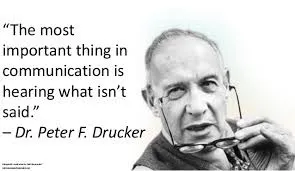The Importance of an Intentional Communication Plan
In This Issue
- The Importance of an Intentional Communication Plan
- Findings about Employee Communication from Recent Gallop Research
- Designing an Intentional Communications Plan
- How to Enhance Workplace Communication and Relationships

Companies spend billions of dollars on recruiting and interviewing, hoping they’ll hire the very best. Every day, business owners face the challenge of losing great employees to competitors because of a disconnect with a manager. That disconnect occurs due to a serious lack of communication between the manager and the employee.
Findings From Recent Gallup Research:
Employees whose managers hold regular meetings with them are nearly three times as likely to be engaged.
Managers who use a combination of face-to-face, phone, and electronic communication are the most successful in engaging employees.
Engaged employees report that when they leave a message for their manager, they receive a response within 24 hours.
Gallup also found employees valued communication from their managers about “what happens in their lives outside of work.” Neglecting to acknowledge and give praise for a job well done will make employees look somewhere else.
People leave managers, not companies; if a company is serious about keeping its best people they need to make sure its managers are giving them reasons to stay.
Mid-managers reported they didn’t understand the company’s direction, didn’t know how decisions were made, and felt left out of conversations that impacted their projects, their clients, and their direct reports.

Top Three Items to Include in an Intentional Company Communication Plan
Companies that are serious about intentional communication have a communication plan that sends strong messages to all employees that can far exceed the short-term effect of a salary increase, or a bonus. Consider the following:
#1: Determine what information needs to be communicated
- What are the company's Vision, Mission, and Values?
- What is the growth strategy?
- How will each employee impact that strategy?
- How will key performance indicators be provided?
- What do the CEO/Principals know that others need to know such as . . .
- Financial status compared to projections,
- Successful new client acquisitions,
- Competitor updates,
- New opportunities.
#2: Determine what and how information will be communicated (email, formal memo, meetings, newsletter)
- Be sure information sent via email is always positive and encouraging. Otherwise, meet face-to-face.
- Increasingly use face-to-face meetings and reduce your email communication.
#3: Design a program, such as one-on-one meetings between managers and direct reports that could have the greatest impact on intentional communication with all employees
- The most effective managers meet weekly with their direct reports
- Encourage dialogue around the following three key areas:
- employee development,
- employee performance, and
- feedforward (a term coined by Marshall Goldsmith, considered the greatest executive coach on the planet).
Goldsmith teaches when an employee receives feedback, they get information about how they’re presently performing. Feedforward is the reverse exercise of feedback and replaces feedback with future-oriented solutions. In simple terms, it means focusing on the future instead of the past.
The skill of effective communication should not be left to chance. It is essential to consistently practice intentional communication, particularly between team members.

How to Enhance Workplace Communication and Relationships
Implement a company-wide development program that includes personal assessments that help all employees to better understand themselves and others, and learn to adapt to each others’ work styles.
The benefits include improved engagement, collaboration, communication, and enhanced working relationships among team members. Team members learn to appreciate the different priorities, preferences, and values everyone brings to the workplace so they can improve engagement, collaboration, and the overall quality of the workplace.
Take The Next Step
Ready For Intentional Communication to Become a Significant Strategic Advantage?
Click on the Button Below to learn more about a process for Improving Workplace Relationships and Communications that considers individual preferences and style.
Click here to learn more about improving workplace relationships and communication
